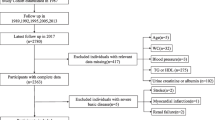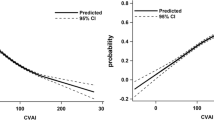Abstract
Background
Chronic kidney disease (CKD) is very common now and is associated with high overall and cardiovascular mortality. Numerous studies have reported that abdominal obesity is a risk factor for cardiovascular mortality. We investigated the link between sagittal abdominal diameter (SAD) and Framingham risk score in non-dialysis CKD patients.
Methods
In a cross-sectional study, we enrolled 307 prevalent non-dialysis CKD patients (175 males, aged 50.7 ± 17.04 years). SAD and Framingham risk score were measured.
Results
Framingham cardiovascular disease risk score was independently predicted by SAD (P < 0.01), GFR (P < 0.01) and diabetic history (P < 0.05). Adjusted R2 of the model was 0.178. SAD could be independently predicted by BMI (P < 0.01), diabetic history (P < 0.01), GFR (P < 0.01) and age (P < 0.01). Adjusted R2 of the model was 0.409. Using receiver operating characteristic (ROC) curve, a cutoff SAD value of 16.55 cm was determined with sensitivity of 63.7%, specificity of 58.3%.
Conclusion
Elevated SAD is significantly associated with increased Framingham risk score in non-dialysis CKD patients. SAD can be predicted by patients’ BMI, diabetic history, renal function and age. Further investigation is needed to explore the potential benefits of central obesity lowering therapy in this patient group.


Similar content being viewed by others
References
Zhang L et al (2012) Prevalence of chronic kidney disease in China: a cross-sectional survey. Lancet 379(9818):815–822
Go AS et al (2004) Chronic kidney disease and the risks of death, cardiovascular events, and hospitalization. N Engl J Med 351(13):1296–1305
Keith DS et al (2004) Longitudinal follow-up and outcomes among a population with chronic kidney disease in a large managed care organization. Arch Intern Med 164(6):659–663
Kopelman P (2007) Health risks associated with overweight and obesity. Obes Rev 8(Suppl 1):13–17
Kannel WB et al (1991) Regional obesity and risk of cardiovascular disease; the Framingham Study. J Clin Epidemiol 44(2):183–190
Kamimura MA et al (2013) Visceral obesity assessed by computed tomography predicts cardiovascular events in chronic kidney disease patients. Nutr Metab Cardiovasc Dis 23(9):891–897
Zhe XW et al (2008) Pulse wave velocity is associated with metabolic syndrome components in CAPD patients. Am J Nephrol 28(4):641–646
Kvist H et al (1988) Total and visceral adipose-tissue volumes derived from measurements with computed tomography in adult men and women: predictive equations. Am J Clin Nutr 48(6):1351–1361
van der Kooy K et al (1993) Abdominal diameters as indicators of visceral fat: comparison between magnetic resonance imaging and anthropometry. Br J Nutr 70(1):47–58
Clasey JL et al (1999) The use of anthropometric and dual-energy X-ray absorptiometry (DXA) measures to estimate total abdominal and abdominal visceral fat in men and women. Obes Res 7(3):256–264
Empana JP et al (2004) Sagittal abdominal diameter and risk of sudden death in asymptomatic middle-aged men: the Paris Prospective Study I. Circulation 110(18):2781–2785
Iribarren C et al (2006) Value of the sagittal abdominal diameter in coronary heart disease risk assessment: cohort study in a large, multiethnic population. Am J Epidemiol 164(12):1150–1159
Lee MJ et al (2013) Sagittal abdominal diameter is an independent predictor of all-cause and cardiovascular mortality in incident peritoneal dialysis patients. PLoS ONE 8(10):e77082
Levey AS et al (1999) A more accurate method to estimate glomerular filtration rate from serum creatinine: a new prediction equation. Modification of Diet in Renal Disease Study Group. Ann Intern Med 130(6):461–470
Nordhamn K et al (2000) Reliability of anthropometric measurements in overweight and lean subjects: consequences for correlations between anthropometric and other variables. Int J Obes Relat Metab Disord 24(5):652–657
Anderson KM et al (1991) Cardiovascular disease risk profiles. Am Heart J 121(1 Pt 2):293–298
Haslam DW, James WP (2005) Obesity. Lancet 366(9492):1197–1209
Scuteri A et al (2005) The metabolic syndrome in older individuals: prevalence and prediction of cardiovascular events: the Cardiovascular Health Study. Diabetes Care 28(4):882–887
Zhe X et al (2012) Hypertriglyceridemic waist is associated with increased carotid atherosclerosis in chronic kidney disease patients. Nephron Clin Pract 122(3–4):146–152
Smith SR et al (2001) Contributions of total body fat, abdominal subcutaneous adipose tissue compartments, and visceral adipose tissue to the metabolic complications of obesity. Metabolism 50(4):425–435
Clasey JL et al (1999) The use of anthropometric and dual-energy X-ray absorptiometry (DXA) measures to estimate total abdominal and abdominal visceral fat in men and women. Obes Res 7(3):256–264
van der Velde M et al (2011) Lower estimated glomerular filtration rate and higher albuminuria are associated with all-cause and cardiovascular mortality. A collaborative meta-analysis of high-risk population cohorts. Kidney Int 79(12):1341–1352
Mafham M et al (2011) Estimated glomerular filtration rate and the risk of major vascular events and all-cause mortality: a meta-analysis. PLoS ONE 6(10):e25920
Segall L, Nistor I, Covic A (2014) Heart failure in patients with chronic kidney disease: a systematic integrative review. Biomed Res Int 2014:937398
Anjana M et al (2004) Visceral and central abdominal fat and anthropometry in relation to diabetes in Asian Indians. Diabetes Care 27(12):2948–2953
Kim SR et al (2011) Relationship of visceral and subcutaneous adiposity with renal function in people with type 2 diabetes mellitus. Nephrol Dial Transplant 26(11):3550–3555
Fouque D et al (2008) A proposed nomenclature and diagnostic criteria for protein-energy wasting in acute and chronic kidney disease. Kidney Int 73(4):391–398
Despres JP (2012) Abdominal obesity and cardiovascular disease: is inflammation the missing link? Can J Cardiol 28(6):642–652
Vasques AC et al (2015) Sagittal abdominal diameter as a surrogate marker of insulin resistance in an admixtured population-Brazilian Metabolic Syndrome Study (BRAMS). PLoS ONE 10(5):e0125365
Pajunen P et al (2013) Sagittal abdominal diameter as a new predictor for incident diabetes. Diabetes Care 36(2):283–288
Riserus U et al (2010) Sagittal abdominal diameter as a screening tool in clinical research: cutoffs for cardiometabolic risk. J Obes 2010:1–7
Lee MJ et al (2013) Sagittal abdominal diameter is an independent predictor of all-cause and cardiovascular mortality in incident peritoneal dialysis patients. PLoS ONE 8(10):e77082
Acknowledgements
The authors thank all the patients and staff of the Division of Nephrology.
This work was funded by grant from Chinese Society of Blood Purification Administration (CHABP2016-07), was supported by Chinese Society of Nephrology Grant (13030310416) and was funded by Special Supporting Program for Young Teachers in Kunming Medical University.
BY was supported by a Grant from Graduate Innovation Fund in Kunming Medical University.
Author information
Authors and Affiliations
Corresponding author
Ethics declarations
Conflict of interest
The authors declare that they have no conflicts of interest.
Rights and permissions
About this article
Cite this article
Xiao, H., Bao, Y., Liu, MY. et al. Sagittal abdominal diameter and Framingham risk score in non-dialysis chronic kidney disease patients. Int Urol Nephrol 50, 1679–1685 (2018). https://doi.org/10.1007/s11255-018-1861-6
Received:
Accepted:
Published:
Issue Date:
DOI: https://doi.org/10.1007/s11255-018-1861-6




